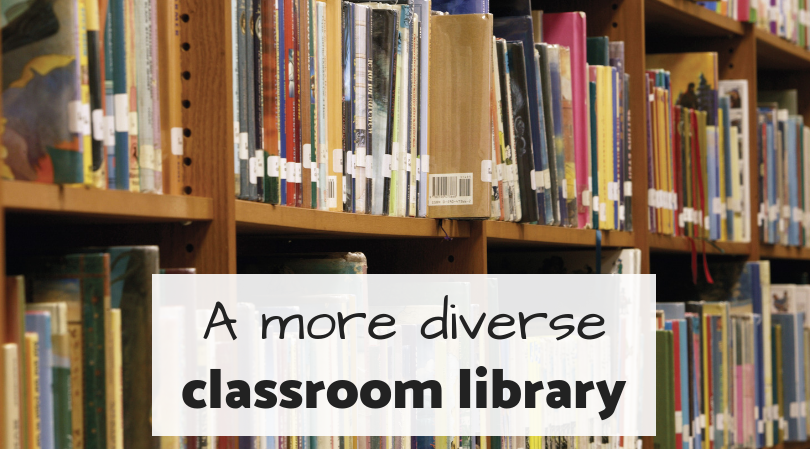
New year, new goals! If one of your professional goals this year is to add more diversity to your school or classroom library, we’re here with some inspiration to get you started. In the following blog post, originally posted at the Center for the Collaborative Classroom and cross-posted with permission, our Director of Curriculum and Literacy Strategy Jill Eisenberg shares tips and suggestions for how to move forward without becoming overwhelmed:
So, you want to build or refresh your classroom library. But how do you do it? What have other schools done? Where do you begin?
If you’ve wondered about any of these questions, you are not alone. Many teachers and schools are leading the charge in infusing more equity and social justice into their daily teaching and culturally responsive books into their reading nooks…most with small to minimal budgets.
Whether you are looking to add more diversity to your classroom library, school bookroom, or just your read aloud shelf (for now!), here are some of the best strategies we at LEE & LOW BOOKS have seen over the past thirty years from schools across the nation.
How does a school implement more diverse libraries?
Rethink your definition of “diversity.”
- The best definition of a culturally responsive classroom library I’ve seen so far comes from the 2018 ILA expert panel: “Classroom libraries as Windows and Mirrors: Ensuring Diverse, Representative Books for Our Students.” (Answer starts at minute 03:05)
- Aim for diversity within diversity—you may have many books about Latinos, but are they “only” about immigration? Look to add titles that explore the range and diversity of experiences, voices, and perspectives within a culture and group.
- Remember that diversity goes far beyond racial representation: it can include language diversity, LGBTQ representation, geographic diversity, family structures and configuration, and much more.
Know where you are starting
“You can’t really know where you are going until you know where you have been.” – Maya Angelou. This is critical: what is already on your shelves? How do you know what you need to buy?
- Do an audit with the classroom library questionnaire—this can be done by you, your students (even as young as fifth grade!), and/or your parents. You might not be starting from scratch or you may discover you want to do a full overhaul.
- Remember: The questionnaire is NOT a test. If your questionnaire answers reveal large gaps in inclusivity, view it as an opportunity, not a failure; now you have a roadmap to go find the new titles!
- Once you see the strengths and (most importantly) the gaps in your collection, be strategic with your budget in acquiring books that capture your students’ experiences or shows them the broader world beyond their communities.
Best offense is a good defense: Get rid of the stereotypes.
Misrepresentation is as harmful as, if not more so, than no representation.
- Don’t be afraid to weed your collection of titles that don’t sit right with you or, if you choose to keep them in, give thought to how you might use them to navigate difficult conversations.
- Unsure if a book is perpetuating a stereotype or misrepresentation? Check out Teaching Tolerance’s Reading Diversity tool to analyze the accuracy, representation, and culturally responsiveness of a specific text.
Recognize how much YOU know your kids and families
No outside organization can prescribe the perfect diversity collection for YOUR classroom or students.
- Lean in to your access to ascertain what matters most to your kids, their backgrounds, experiences, and values.
- What matters to them?
- What is a mirror for your students?
- What will be a window for your students? What might be new for them?
- Study students’ writing samples: their small moments pieces, daily journal or reading responses, and personal narratives.
- Mine your conversations from parent-teacher conferences, home visits, Back to School night, and field trips.
Realize that you have a village here!
You are not the first, and certainly won’t be the last, to seek culturally relevant and responsive books for your students. Many, many schools and districts are working hard to diversify and update their classroom libraries and bookrooms.
- Find your local experts. Do you have a school librarian or literacy specialist/coach on site you can enlist and brainstorm with? Can someone from the district recommend a book expert? Who is the public library’s children or teen specialist?
- Look to leaders in the field already doing the heavy lifting on identifying accurate, high-quality, captivating diverse titles. Award committees, academics, literacy organizations, and educator and parenting blogs are reviewing thousands of titles so you can trust you are giving your students the best of the best.
Complement and supplement; don’t throw out.
If there is a curriculum staple or you have a personal favorite, please keep using it. However, consider ways to add a “read alike” that makes it more contemporary or relevant to your students. We Need Diverse Books has a wonderful read alike collection of blockbuster titles and classics paired with award-winning diverse titles.
Remember: You are in this for the long haul.
“Champions keep playing until they get it right.”– Billie Jean King. If you add a few critical titles to your collection this year, you are on your way. Teachers build their libraries over many years. You are off to a great start.
Jill Eisenberg is the Director of Curriculum and Literacy Strategy at LEE & LOW BOOKS, the largest independent children’s book publisher specializing in diversity and multiculturalism. Before joining LEE & LOW, Eisenberg was a Fulbright Fellow in Taiwan where she taught English as a foreign language to grades 2–6. She went on to become an ELA teacher for third grade in the Bay Area in California and has been passionate about best practices for supporting English Language Learners and parent engagement ever since. At LEE & LOW BOOKS, she oversees strategic partnerships and provides product and literacy expertise to schools, districts, and literacy organizations.








